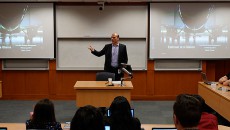It’s no surprise really: When unemployment is on the rise—like it is today—employee absenteeism drops as workers worry about losing their jobs when new ones are scarce. But is this always a good thing for employers?
According to a new study involving thousands of employees of a state department of transportation working in units across the state, this shift in absenteeism may ultimately not benefit employers.
[flv:http://business.fiu.edu/newsletters/BusinessNetworks/2009/02/videos/hiller.flv 500 334]
“Engaged and satisfied workers are on the job through thick and thin,” said Nathan J. Hiller, assistant professor, Department of Management and International Business, College of Business Administration. “On the other hand, disengaged, disaffected workers are much more likely to show up only during the thin times. On the downside, the employees who show up more when the economy is difficult are those whose contributions to productivity are likely to be the least.”
Hiller collaborated on the study, entitled “Work Unit Absenteeism: Effects of Satisfaction, Commitment, Labor Market Conditions, and Time,” with John P. Hausknecht, Cornell University, and Robert J. Vance, principal, Vance & Renz, LLC.
Both job satisfaction and commitment to the organization play a key role in absenteeism.
According to Hiller, the study also shows that in areas with high unemployment, absenteeism was about seven to eight percent less than in areas with low unemployment, provided the unit was low on commitment or satisfaction. In contrast, in units with high satisfaction or commitment, local unemployment rates had little, if any, effect on job absences, because absenteeism in those groups was consistently low.
On the positive side for employers, this means that when a company’s workforce is satisfied and committed, it really doesn’t matter what the economy is doing—as those employees tend to be the ones who are not missing days at work.
The study also contains another piece of insightful news for employers: Worker absenteeism has a tendency to creep up over the years if left unchecked, through good and bad times alike.
“Absenteeism isn’t always a bad thing, but it can viewed as a general barometer of how well a unit is being run,” Hiller said. “A spike in absences may indicate that bigger problems in the unit are just around the corner.”
Study resonates around the globe.
First published in the January, 2009 issue of the Academy of Management Journal, the workforce absenteeism study quickly spread to an international audience. A Reuters news wire article appeared in MSNBC and Yahoo online news and other business and news outlets in Canada, India, Philippines, United Kingdom, and the United States.
“Clearly, the study reaches across different business cultures at a time when employers are concerned about how employees can help their businesses survive and sustain competitive advantage,” Hiller said.


